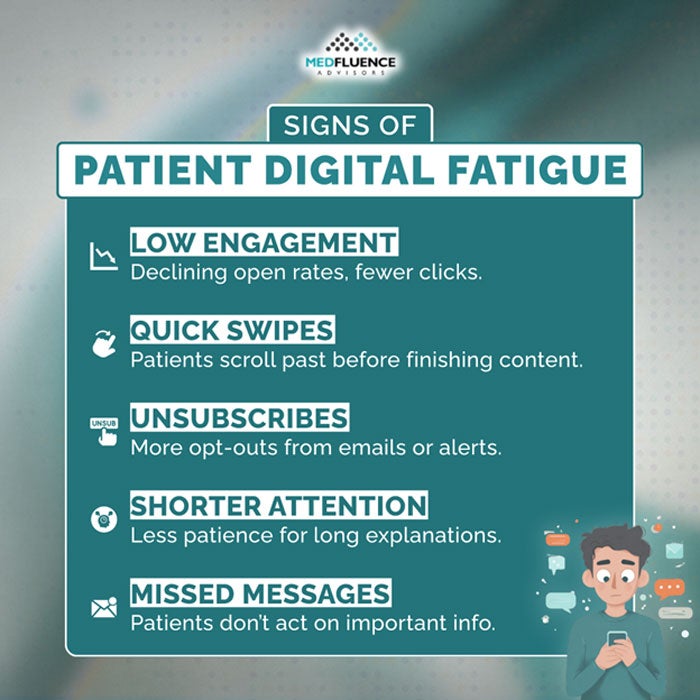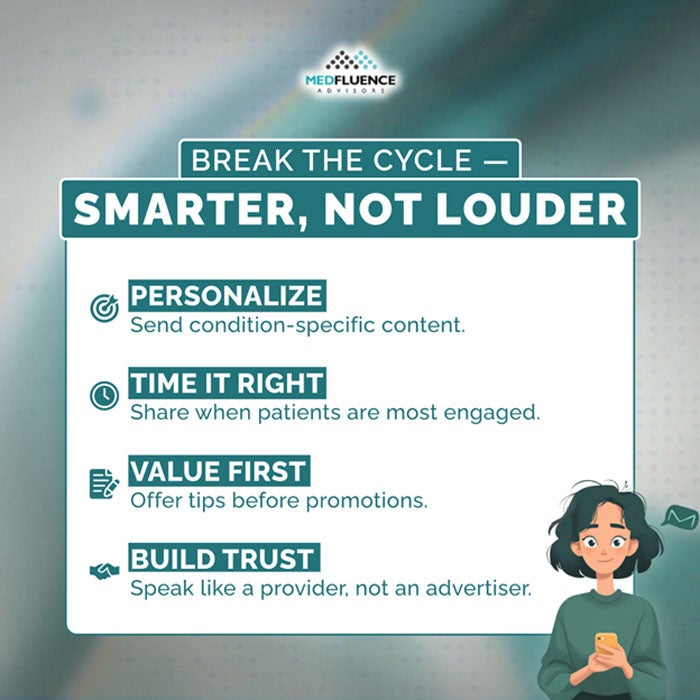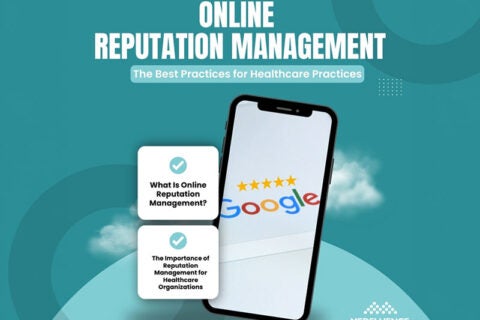Digital Fatigue in Patients: Are Your Campaigns Adding to the Noise?

The internet was supposed to make connecting with patients easier. Now, it’s crowded with pop-ups, inbox clutter, endless scrolling, and an overwhelming flood of “must-read” health advice.
Your potential patients are tired. They’ve seen too many ads, signed up for too many newsletters, and watched too many “limited-time” offers come and go. This isn’t just a consumer issue—it’s a healthcare problem. When every voice is shouting at once, the people who actually need help can’t hear the ones offering real solutions.
If your practice is unknowingly adding to the noise, your campaigns could be getting lost in the very chaos you’re trying to rise above. The challenge now isn’t just being seen—it’s being trusted and remembered by patients whose attention is running on empty.
What is Digital Fatigue in Healthcare?
Digital fatigue isn’t just a buzzword—it’s a very real cognitive and emotional response to constant online stimulation. It happens when people are overwhelmed by the sheer volume of digital content. The human brain isn’t built to process thousands of micro-messages a day without eventually hitting a saturation point.
For patients, this fatigue doesn’t just lead to mild irritation—it can cause them to disengage completely. They skim instead of read, delete messages without opening them, or scroll past important information simply because their attention is already drained. Even the most valuable health-related messages can get lumped into the “just more noise” category if they arrive at the wrong time, in the wrong format, or too frequently.
In healthcare marketing, this means you can be producing well-researched, genuinely helpful content, but if it’s delivered in a way that competes with dozens of other digital demands, it risks being ignored or forgotten.
Signs Your Patients Are Experiencing It
Digital fatigue in your patient audience can be detected long before someone says, “I’m tired of all these emails.” The warning signs often show up in your marketing metrics and patient interactions:
- Drop-off Rates: Patients start an article or video but click away before finishing. Long scroll times on social posts turn into quick swipes past your content.
- Low Engagement: Open rates on emails decline. Fewer likes, shares, or comments on posts that used to spark conversation.
- Unsubscribes and Opt-Outs: A steady increase in people removing themselves from your mailing list or turning off notifications from your social channels.
- Reduced Click-Through Rates: Patients are still seeing your campaigns, but fewer are taking the next step—whether that’s clicking a link, booking an appointment, or downloading a resource.
- Shorter Attention Spans in Conversations: Even in direct patient communications, you may notice people asking for more concise explanations or skipping over details they would’ve engaged with in the past.
These signs don’t always mean your content is poor—it often means your audience’s mental “bandwidth” is already full. Understanding this is critical because the reflexive response to declining engagement is often to produce more content, when in reality, what patients need is less content, delivered more thoughtfully.
If you can identify digital fatigue early and adjust your approach, you’re far more likely to keep patients engaged—and most importantly—get essential health information in front of the people who need it most.

How Over-Marketing Contributes to Patient Fatigue
Think about your own online experience: before lunch, you’ve probably seen dozens of ads, scrolled past hundreds of posts, and deleted more emails than you’ve read. Your patients are living the same reality—only they’re often carrying the added mental load of trying to manage or understand a health issue.
In healthcare, many practices approach marketing with a “more is better” mentality—more emails, more posts, more retargeted ads. On paper, this sounds like increasing visibility. In reality, it often creates a content avalanche where patients feel buried. Instead of your message standing out, it becomes just another grain of sand in the desert.
The more patients feel bombarded, the more they start tuning out—sometimes selectively (“I’ll just delete anything from a doctor’s office today”) and sometimes indiscriminately (“I’m unsubscribing from everything”). This means your campaigns aren’t just competing with other practices—they’re competing with every notification on a patient’s phone.
When “Helpful” Becomes Overwhelming
Healthcare marketers often fall into a trap: believing that if information is valuable, it can’t be overwhelming. Unfortunately, even well-intentioned patient education campaigns can cause fatigue if they lack restraint.
Let’s say you’re running a series on chronic sinus issues. You publish three blog posts a week, send a weekly newsletter, post daily tips on Instagram, and send a monthly webinar invite. To you, it’s helpful and thorough. To the average patient juggling work, family, and health concerns, it can feel like homework they never asked for.
It’s not that patients don’t want information—they do. But they want it in doses they can absorb, at times when they’re ready for it, and in formats that feel approachable rather than exhausting. Overloading them, even with good content, has the same result as sending irrelevant promotions: they stop engaging.
Generic Messaging vs. Patient-Specific Needs
Another major contributor to patient fatigue is messaging that’s too broad. Many practices send one-size-fits-all campaigns because it’s efficient—but efficiency for the sender often means irrelevance for the receiver.
If your email about seasonal allergies goes to all your patients, you’re asking people who don’t have allergies to use up mental space on something they’ll never act on. Multiply that by a dozen similar campaigns, and you’ve trained patients to assume most of your communications don’t apply to them—so they stop reading altogether.
Generic messaging also dilutes trust. Patients are far more likely to engage with campaigns that feel like they were designed for their situation, not just the general public. Without that personal relevance, even beautifully designed content can feel like noise.
The Illusion of Activity
Over-marketing is sometimes less about strategy and more about fear. When practices see engagement dropping, they often push out more content in the hope that something will stick. This creates the illusion of activity—metrics like “number of posts” or “emails sent” go up—but actual patient connection goes down.
The problem is that patients don’t measure your marketing efforts by how much you send; they measure it by how much value they get. Sending more without a clear plan is like talking louder in a noisy room—it doesn’t make you easier to understand, it just adds to the noise.
Why This Matters More Than You Think
Over-marketing doesn’t just waste resources—it actively erodes the relationship between patient and provider. Patients start associating your name with overload rather than help. And in healthcare, where trust is the currency, that’s a debt you can’t afford.
Understanding how over-marketing accelerates digital fatigue is the first step toward reversing it. The next step is seeing the real-world consequences of letting fatigue set in—because it’s not just about clicks and open rates, it’s about whether patients get the care they truly need.
The Cost of Being Part of the Noise
When your marketing blends into the constant digital hum, the impact isn’t just lower engagement—it’s lost opportunities for care. Patients dealing with undiagnosed or chronic conditions are often looking for answers, but digital fatigue makes them more likely to scroll past important information, even if it could improve their quality of life.
Lost Attention = Lost Opportunity
Every time a patient ignores a message, you lose a chance to guide them toward the next step—whether that’s booking a consultation, attending a screening, or simply learning about an effective treatment. In healthcare, these missed moments can delay diagnoses, prolong suffering, or keep patients from accessing procedures that could offer real relief.
Erosion of Trust
If patients feel overwhelmed or see your name too often without relevance, they start associating your practice with noise rather than value. Once trust starts to erode, it’s hard to rebuild—especially in healthcare, where credibility is everything.
The “Scroll Past” Effect
Digital fatigue doesn’t always mean patients dislike your content; sometimes, they simply stop noticing it. Your campaigns may still be reaching inboxes and feeds, but if they’ve become part of the background clutter, they might as well not exist.
In other industries, this means lost sales. In healthcare, it means lost relationships—and potentially, worse health outcomes for the people you want to help.
The challenge isn’t about making more noise; it’s about breaking through in a way that patients actually welcome. And for smaller practices, that means rethinking how, when, and why you reach out—before your voice gets drowned out entirely.

Breaking Through Without Burning Out Patients
The instinct when engagement drops is often to do more—more posts, more emails, more ads. But when your patients are already experiencing digital fatigue, “more” doesn’t fix the problem. In fact, it’s the very thing making it worse. The real challenge is figuring out how to remain visible and valuable without overwhelming the people you want to help.
Less, but Smarter
Instead of focusing on sheer output, shift your strategy toward intentionality. Every piece of content should answer three questions before it’s sent:
- Does this matter to the patient right now?
- Is it framed in a way that feels relevant to them, not just the practice?
- Does it add something new—or are we repeating ourselves?
This mindset naturally trims unnecessary messages and forces every touchpoint to earn its place in your marketing calendar. When you reduce noise, the content that remains has a better chance of standing out.
Personalization Over Saturation
Relevance is the antidote to fatigue. Segment your audience based on their health concerns, treatment stage, or past interactions with your practice. Patients dealing with chronic sinus issues shouldn’t get the same messaging as those interested in allergy testing.
Personalization doesn’t have to mean writing 20 different newsletters—it can be as simple as:
- Adjusting subject lines to reflect the patient’s condition.
- Sending seasonal tips that apply only to relevant segments.
- Following up with resources that match a patient’s inquiry history.
When patients feel like you’re speaking directly to them, they’re far more likely to engage—no matter how much other digital noise surrounds them.
Timing and Frequency
Even relevant content can become tiring if it’s sent too often or at the wrong time. Review your analytics to see when your audience actually engages. If most email opens happen on Wednesday mornings, there’s no need to send reminders on Monday and Friday, too.
Spacing out your touchpoints not only reduces fatigue but also creates a sense of anticipation. Patients begin to view your communications as something to look forward to, rather than something to delete.
Value-First Approach
Every interaction should deliver value before asking for anything in return. That value might be a practical health tip, a patient story that builds hope, or an answer to a common question.
For example: instead of “Book your sinus evaluation today,” lead with “Three simple changes to reduce daily sinus pressure.” At the end, you can invite them to book an appointment if they need more help. This approach makes your message feel like a service, not a sales pitch.
The Power of Restraint
One of the most effective ways to stand out in a crowded digital space is simply to communicate less frequently—but with more impact. Think of it like a conversation with a good friend: you don’t text them every hour just to stay in touch. You reach out when you have something meaningful to say.
In a healthcare landscape where every provider is trying to be the loudest, the quiet, intentional voice is often the one patients remember.
Building Campaigns Patients Actually Want to See
You can’t fight digital fatigue by yelling louder. The way forward is to create campaigns that feel less like marketing and more like a genuine extension of the care you provide. When patients sense that your content is designed for them—with their needs, challenges, and emotions in mind—they’ll pay attention even in a noisy online world.

The Story-Driven Method
Facts are important, but stories are unforgettable. Sharing real patient journeys (with permission) can bridge the gap between “another medical ad” and a message that resonates on a personal level. Instead of leading with a list of services, tell the story of a patient who struggled for years before finding relief through your practice. Stories create emotional investment, which can cut through even the most crowded feeds.
Education with Clarity, Not Complexity
Healthcare information can be overwhelming, and dense explanations only add to the fatigue. Break down complex topics into plain language, short sentences, and clear takeaways. Instead of a 1,200-word article on sinus surgery techniques, give patients a “Before & After” style explanation that answers the questions they’re already asking: Will this help me? What will recovery be like? How soon will I feel better?
Creating Relief in the Messaging Itself
If your goal is to help patients feel better, your content should reflect that—both in tone and in design. Use calm, straightforward language. Choose visuals that convey comfort rather than urgency. Avoid overwhelming layouts filled with too many CTAs or flashing graphics. The very act of reading your message should feel like a break from the digital noise, not more of it.
Format Matters
Patients are not all consuming information the same way. Some prefer short videos, others like bite-sized text posts, and some still want long-form articles. Repurpose your core message into multiple formats so patients can engage in the way that works best for them—whether that’s a 60-second Instagram video or a printable tip sheet they can stick on the fridge.
A Consistent, Familiar Voice
Patients are more likely to trust and remember your campaigns when your tone stays consistent. That doesn’t mean robotic—it means predictable in the best way. Whether you’re writing a blog, posting on Facebook, or sending an email, the voice should always sound like the same caring professional they’d meet in your office.
When you build campaigns that make patients feel understood and supported, you’re not just avoiding digital fatigue—you’re replacing it with digital trust. And in a healthcare environment flooded with information, trust is the currency that matters most.

Cut Through the Noise—So the Patients Who Need You Can Finally Hear You
Digital fatigue isn’t just an inconvenience—it’s a barrier between patients and the care they’ve been searching for. When the online world feels like a blur of promotions and pop-ups, people start tuning out, even when the message could change their lives.
For private practices, the challenge isn’t about pushing harder—it’s about showing up in ways that feel relevant, timely, and genuinely helpful. Every post, email, or ad should feel less like marketing and more like a moment of clarity in the middle of the noise.
When you slow down, get intentional, and focus on value over volume, you don’t just improve engagement—you give patients space to truly hear you. And for many, hearing you might be the first step toward finally getting the relief they’ve been waiting for.
At Medfluence, we believe the right message, shared the right way, can be the difference between a patient scrolling past and a patient finally taking the step to get help. It’s not about being everywhere. It’s about being there when it matters most.


